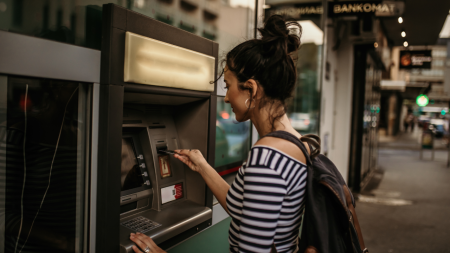Key takeaways
- Money market accounts combine savings features with checking-like access through debit cards and check-writing.
- The top high-yield savings accounts currently earn up to 4.50 percent APY, while top money market accounts earn up to 4 percent APY.
- Money market accounts often require higher minimum balances but offer more transaction flexibility than traditional savings accounts.
- You can have both account types to separate short-term accessible funds from long-term savings goals.
Money market accounts and savings accounts are both financial products that allow you to save and withdraw cash. These types of deposit accounts provide easy access to your funds and may pay competitive yields, both of which can be important during periods of economic uncertainty and inflation.
While savings accounts and money market accounts share some similar features, there are key differences in how you’re able to use them. Understanding the rules of each can help you decide which one is best for your financial goals.
Money market accounts vs. savings accounts
Both money market accounts and savings accounts allow you to deposit money and earn interest. The main difference lies in account features and accessibility. Money market accounts often come with transactional features — such as check-writing abilities and debit cards — while savings accounts typically focus solely on growing your money.
Money market accounts combine features of checking and savings accounts. They typically offer higher interest rates than checking accounts while providing some spending tools like debit cards or check-writing privileges. Most require higher minimum balances to earn the best rates.
Savings accounts, especially high-yield savings accounts, focus purely on earning interest with minimal transaction features. They’re designed to help you save money rather than spend it, making them best for specific financial goals.
“I recommend money market accounts when you need some transaction flexibility but want to earn more than a checking account. Think of them as a middle ground between savings and checking — perfect for your emergency fund when you might need quick access to pay an unexpected bill.”
— Hanna Horvath, Managing Editor, Banking
Money market account vs. high-yield savings account
When comparing money market accounts to high-yield savings accounts specifically, the rate advantage often goes to high-yield savings accounts. Many top high-yield savings accounts currently offer rates up to 4.50 percent APY, while top money market accounts reach up to around 4.30 percent APY.
The following chart breaks down which features may be provided with savings accounts and money market accounts:
| Savings account | Money market account | |
|---|---|---|
| Earns interest | Yes | Yes |
| ATM withdrawals | Yes | Yes |
| Unlimited withdrawals without excessive transaction fees* | No | No |
| Check-writing | No | Sometimes |
| Debit card | No | Sometimes |
| Automated deposits possible | Yes | Yes |
| FDIC/NCUA-insured | Yes | Yes |
*The Federal Reserve removed Regulation D withdrawal limitations in 2020 that banks had been required to impose on savings accounts. This allowed banks to let customers make more than the standard six maximum withdrawals and transfers each month without incurring any excessive transaction fees. Check with your bank to clarify its withdrawal limit rules; many banks didn’t ease their policies despite the Fed ruling.
Key statistics on savings accounts and money market accounts
- The national average yield for savings accounts is 0.60 percent as of June 2025. Rates more than 7 times higher can be found at some online banks and credit unions.
- The national average yield for money market accounts is 0.44 percent as of June 2025. Rates more than 10 times higher can be found, however, by shopping around for competitive money market accounts.
- More than half of savers (51 percent) have a savings or money market account with an online bank, according to Bankrate’s Saving Account Survey.
- The median balance for transactional accounts, such as savings accounts and money market accounts, is $8,000.
Find today’s best savings rates →
How to choose between a money market account and a savings account
You don’t have to choose between these account types — many people benefit from having both. For example, you could use a savings account for long-term goals like a house down payment, while keeping a money market account for paying bills and occasional purchases.
However, if you want to focus on one account type, here’s what to consider:
Determine what the money’s for
Start by determining the use of the funds. You may be interested in growing an emergency fund, saving for a down payment on a house or paying for a vacation. Once you know your purpose for the money, review the pros and cons of each product to determine which one is best for you.
Choose a savings account if you’re:
- Building long-term savings goals
- Growing an emergency fund you won’t touch frequently
- Focused on maximizing interest earnings
- Comfortable with online-only banking for better rates
Choose a money market account if you:
- Want occasional check-writing ability
- Need debit card access for flexibility
- Prefer having some transactional features
- Can meet higher minimum balance requirements
Remember that easy access to funds can work against you if you’re trying to limit spending. If you’re prone to impulse purchases, a savings account without spending tools might be the better choice.
Compare interest rates
Interest rates should be a primary factor in your decision. High-yield savings accounts currently offer some of the most competitive rates available, often exceeding traditional money market account rates.
Don’t settle for big bank standard rates (often under 0.10 percent APY). Compare both online banks and credit unions for the highest yields, and look for accounts with no minimum balance requirements. Also make sure to consider promotional rates carefully — they may decrease after an introductory period.
Money market accounts may feature tiered rates based on balance amounts, paying higher yields for larger deposits. Make sure you can maintain the required balance to earn the advertised rate.
Compare money market account rates →
Watch out for fees
Both account types can charge monthly maintenance fees if you don’t meet certain conditions, such as maintaining a minimum balance or making regular deposits. These fees can quickly erode your interest earnings.
Common fees to avoid include:
- Monthly maintenance fees: $5 to $25 per month if requirements aren’t met
- Excess withdrawal fees: Charges for exceeding transaction limits
- Minimum balance fees: Penalties for falling below required amounts
- ATM fees: Out-of-network charges for withdrawing cash
Here is Bankrate’s complete list of common bank fees and tips to avoid them.
Many online banks offer fee-free accounts, making them attractive alternatives to traditional brick-and-mortar institutions. Always read the fine print to understand all potential charges.
Money tip:
Consider opening both account types to separate your emergency fund (money market) from long-term savings goals (high-yield savings).
Pros and cons of savings accounts
Pros
- Competitive interest rates available, especially from online banks
- Insured if at a bank that’s a member of the Federal Deposit Insurance Corp. (FDIC), or a credit union that’s a member of the National Credit Union Administration (NCUA)
- Simple account structure focused on growing your money
- Lower minimum balance requirements than money market accounts
- No temptation to spend due to lack of transactional features
Cons
- No check-writing ability limits payment flexibility
- No debit card access requires transfers for spending
- Withdrawal limitations may apply depending on bank policy
- Traditional banks offer low rates often under 0.25 percent APY
Despite potential limitations, having a dedicated savings account is essential for building financial security and achieving your money goals.
Pros and cons of money market accounts
Pros
- Transactional features including checks and debit cards
- FDIC/NCUA insurance protection at insured institutions
- Competitive rates available, though often lower than high-yield savings
- Flexibility for both saving and occasional spending needs
Cons
- Higher minimum balance requirements to earn best rates and avoid fees
- Easy spending access can work against savings goals
- Limited monthly transactions, typically around six per month
- Lower rates compared to top high-yield savings accounts
- More complex fee structures than basic savings accounts
While there are some unique drawbacks to certain money market account offerings, plenty of depositors opt to have a money market account alongside a savings account for the ability to earn extra interest while paying bills and using a debit card.
Next steps: Compare high-yield savings accounts and money market account rates to find the best options for your needs.
Bottom line
Both savings and money market accounts are valuable tools for managing your finances, especially in today’s high-rate environment. The best choice depends on your specific needs, spending habits, and financial goals.
Consider a high-yield savings account if you want to maximize earnings on money you won’t need to access frequently. These accounts typically offer the highest rates and simplest fee structures.
Consider a money market account if you want the flexibility to write occasional checks or use a debit card while still earning interest on your balance.
Many successful savers use both account types strategically — keeping long-term savings in high-yield accounts while maintaining money market accounts for flexible access to funds. This approach lets you optimize both growth and accessibility. As you evaluate your options, focus on finding accounts that offer competitive rates, reasonable fees and features that match your banking preferences.
Related articles:
Why we ask for feedback
Your feedback helps us improve our content and services. It takes less than a minute to
complete.
Your responses are anonymous and will only be used for improving our website.
Help us improve our content
Read the full article here












